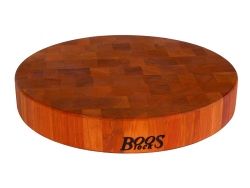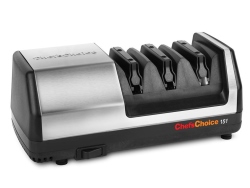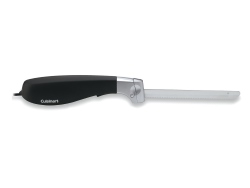Cutting boards are one of those things that people buy without giving much thought to it. A good, proper cutting board, though, will let you prepare foods in a safe manner while protecting countertops and allowing knives to stay sharp much longer. Choosing the right board is especially important for those who cook in kitchens with little counter space, as the board itself can act as an extension of the counter.
To help you select the right cutting board, we reviewed and compared 35 different cutting boards in order to create this buyer’s guide and list of the four best models.
Best Overall: John Boos R03 Maple Wood Reversible Cutting Board
Easily our top pick, the John Boos R03 is one of the most durable and highest quality wood cutting boards you can buy. This edge grain board made by John Boos, the most recognized name in cutting boards, is made of solid rock maple and weighs in at a hefty 12 pounds. Its large 20″ x 15″ cutting surface can handle just about any food prep task in the home, from slicing piles of vegetables to chopping through stubborn chicken bones.
The John Boos R03 is also a reversible cutting board with two finished sides, and can be flipped if one side gets too scarred up. You can even flip it between uses in order to evenly distribute the wear and tear on both sides and extend the time before the surfaces need to be refinished. As a convenience, this board comes with finger grips cut into the sides of it to make it easier to move it from one area of your countertop to another.
One of the first impressions people who first use this board have, especially if they have only dealt with little mini boards, is its size. As a standard kitchen counter is 24 in. in depth, the John Boos R03 can take up over half the counter. After getting over the shock, though, people tend to fall in love with the size. Being able to cut all the different vegetables into separate little piles and do it all on the same board at once can save you a lot of time and effort.
Best Bamboo Cutting Board Totally Bamboo Big Easy 20-3050
The Totally Bamboo Big Easy is a very popular cutting board made from organically grown bamboo. If you’re someone who worries about the environmental impact of using wood products, but wants a top notch cutting board made of natural, high-quality materials, then this is the board for you.
This large flat grain bamboo cutting board sits at a tall 3.25 inches due to its rubber feet, which provide a much more significant benefit than one would think. Such a big advantage, in fact, that those who buy flat boards often find themselves heading to the hardware store to get their own rubber feet to install on their boards.
To keep them from sliding around and rocking in situations where the countertop or the cutting board itself may not be perfectly flat, cutting boards without rubber feet need to be placed on a towel. In addition to the added safety of the traction provided by the rubber feet, they provide another advantage in that they keep the board above the surface of the counter. With large real wooden cutting boards, people often prefer to leave it out on the counter as a convenience. After months of use, they sometimes find to their horror that the underside of the board has mold or fungus growing on it because it has been sitting on a layer of moisture trapped between the counter and board. The feet keep the board off the surface and prevent this.
Best Value: Michigan Maple Block AGA01812 Wood Cutting Board
The Michigan Maple Block AGA01812 is comparable in quality to our top pick, the John Boos R03, but is slightly less expensive. This edge grain rock maple cutting board is a great option for those who want to upgrade from a plastic/synthetic model to a better, higher quality wood cutting board, but don’t want to pay quite as much to buy a very high-end model. Measuring 18″ by 12″ with a thickness of 1.75″, the Michigan Maple Block AGA01812 is large enough to easily handle big cutting tasks, but isn’t too large so as to make it difficult to handle or wash. Although some people might prefer a slightly larger size, many prefer the somewhat smaller size of this cutting board.
Since this cutting board is made of real wood, there is one thing that people who are considering buying this board should be aware of. Real wood can warp or crack if it gets too wet or too dry. While the Michigan Maple Block AGA01812 is oiled for protection before leaving the manufacturer, there is no way to know what environmental factors it may have encountered during transit. Because of this, any cutting board made of natural materials should be seasoned before its first use.
4 Best Budget Model: OXO Good Grips 1063789 Synthetic Cutting Board
For those who want a large, substantial cutting board without the premium price tag or maintenance required of a natural wood or bamboo product, the OXO Good Grips 1063789 is a good choice. Measuring 14.5″ by 21″, this cutting board will give you plenty of surface area to cut several ingredients to put into their own little piles.
In addition, the OXO Good Grips 1063789 is reversible.. sort of. There is a rubber rim around the edge of the board that acts as feet – but only in one direction. With the board face up, you have access to the side with a juice groove to keep the juices from cutting tomatoes or meat from dripping off the edge of the board. Flipping the board around allows access to the other side, which is perfectly fine as a cutting surface. However, the reverse side does not have a juice groove, nor does the rubber rim extend far enough to act as feet for the back side of the board, so you’ll want to place a towel underneath it to keep it secure when cutting foods on it.
One thing you’ll especially like about this board is that it only weighs around 3 pounds, making it quite light. Compared to the beefier boards above, this lightweight model provides a more mobile solution for those who might struggle to maneuver a more weighty board.
For those who simply want a decent cutting board at the lowest price available, the OXO Good Grips 1063789 is a solid choice. And even if you already have or are planning on buying a better wood or bamboo board, you can always pick one of these up as a backup to your primary cutting board for situations where you may need a smaller and more mobile board. Read reviews on Amazon >
Cutting Board Buying Guide
Unlike many important purchases, there are really only two considerations when shopping for a quality cutting board: size and material. The right size is, of course, purely a matter of what a person needs in terms of cutting space and the ability to store the cutting board. Below, we’ll break down the various materials available and what their relative pros and cons are. With this information in hand, anyone shopping for a cutting board can pick the one best suited for their specific needs.
Plastic
The least expensive cutting boards are usually made of plastic or some composite material. Compared to wood, they tend to be a lighter weight alternative. One particular benefit of a plastic cutting board that many find to be the deciding factor in buying one is that many plastic cutting boards are dishwasher safe. While this can definitely be a convenience, be aware that not only can you use a dishwasher to clean them, you must use a dishwasher to be sure they are really clean.
As you use a plastic cutting board, the knife makes cuts in the surface of the cutting board. How deep these cuts are depend on the hardness of the particular cutting board, the sharpness of the knife and the force used in cutting. Regardless of these variables, any plastic cutting board eventually develops these cuts. The problem is that these tiny slices in the cutting board provide an area where bacteria can gain a foothold and begin to grow a colony. Once this process starts, even vigorous hand scrubbing is not enough to guarantee that the bacteria are completely removed from the board. Only the heat and high pressure spray found in a dishwasher is enough to really be sure any salmonella or other potential bacteria are killed.
The final advantage of plastic cutting boards is the fact that they require no maintenance. You take it out of storage, you use it, you clean it and store it again until next time. There is no oiling or other maintenance in between. For people who only need a large cutting board every blue moon to make large holiday meals or something similar, a plastic or synthetic cutting board may suffice.
Bamboo
The next material is one that is becoming more common every day: bamboo. Bamboo, like wood, is a natural material. Because of this, it comes from a renewable resource that is biodegradable, so it will not spend the next thousand years in a landfill. Unlike wood, bamboo cutting boards are made from the fastest growing plant on the planet. Bamboo can grow several feet each month. Because of this, a cutting board made of bamboo represents a far shorter growing cycle when compared to traditional wooden cutting board materials. This shorter growing cycle is another plus in the eco friendly column for bamboo products, as the bamboo plant has used far fewer nutrients and other resources to reach maturity.
Bamboo cutting boards will tend to be about half the weight of a comparable wooden cutting board. While still substantial when you are dealing with a large cutting board, this lower weight is often an attractive feature for those who have trouble lifting things.
Compared to plastic cutting boards, bamboo cutting boards have one benefit beyond being a natural material. Becuase bamboo is composed of tiny fibers instead of the more solid structure found in plastic, the cuts made by a knife on a bamboo cutting board are somewhat self healing. In other words, as the knife slices across the surface it leaves the same kind of indentation it would on a plastic board, but many of the bamboo fibers are not actually cut, they are just crushed by the knife. Given a little time, these crushed fibers will recover their natural shape and often completely heal the cut. There are obviously limits to this phenomenon, but the simple fact that bamboo fibers act this way helps eliminate much of the danger represented by bacteria finding hiding places within cuts on a cutting board surface.
Compared to wooden cutting boards, bamboo cutting boards tend to be slightly less expensive and a bit less durable. While a properly maintained bamboo cutting board may last many years, a properly maintained wooden cutting board may last generations. This fact and the fact that bamboo grows so quickly are reflected in the price. A bamboo cutting board will generally cost noticeably less than a wooden cutting board of similar quality.
Wood
The last most commonly used material is wood. Traditionally, walnut and maple are considered the best woods for cutting boards. These woods represent a good compromise between being hard enough to stand up to years of cutting and soft enough not to quickly dull knives used on them. Because maple has a huge growing range that spans much of the US and Canada, most new cutting boards made of wood tend to be maple.
Edge Grain vs. End Grain
For all intents and purposes, wooden cutting boards are identical to bamboo cutting boards; they are just heavier, more expensive and more durable. They require the same sort of maintenance a bamboo cutting board needs, are biodegradable and self heal small cuts. Both wooden and bamboo cutting boards can be further divided into two types, based on what direction the wood is cut for the board.
Imagine a typical wooden plank. It has three planes: the face (the wide part), the edge (the narrow part) and the end (the end, naturally).
Wooden projects that are built to show off the beauty of wood use a face grain orientation. This orientation is not used in cutting boards because the face grain is soft enough that any heavy knife work on it would quickly make it split into an unusable mess.
Some cutting boards use an end grain orientation. The big advantage of using an end grain cutting board is the fact that it will preserve the sharpness of a knife for a long time. The drawback is that end grain is more succeptible to splitting, allowing moisture to more easily seep into the cutting board.
The majority of modern cutting boards use an edge grain orientation. The edge grain orientation allows the cutting board to last as long as possible because it has good durability versus knives and good resistance to the infiltration of the board by moisture.
Whether an end grain or edge grain cutting board is better purely depends on whether the person who buys the board wants the board itself to last longer or would prefer to sacrifice that durability to avoid the need to sharpen knives as frequently.
Other Material Types
There are other materials some people choose to use as cutting surfaces, such as ceramic or marble. These materials are not recommended unless you absolutely care nothing for your knives. A knife can be used on a good wooden cutting board for months without requiring major resharpening, years if the person doing the cutting has a light touch. Just a couple of uses on a ceramic surface will turn a razor sharp chef’s knife into an expensive butter knife. Bottom line: great countertop material makes for a very bad cutting surface.
Comparison Chart
Our Top Pick
$$$$
Maple Wood
Edge
Yes
20″ x 15″ x 1.5″
12 lbs.
Best Value
$$$
Maple Wood
Edge
Yes
18″ x 12″ x 1.75″
9 lbs.
Best Budget Model
$
Plastic
N/Ax
Yes (Grooved 1 Side Only)
21″ x 14.5″ x 0.5″
3.2 lbs.
Best Bamboo Board
$$$$
Bamboo
Flat w/ End Grain Inlay
No
19″ x 13.5″ x 3.25″
7.4 lbs.
Top Rated
$$$$$
Cherry Wood
End Grain
No
15″ x 15″ x 2.5″
12 lbs.








 Top 7 Knife Sharpeners
Top 7 Knife Sharpeners 3 Best Electric Knives
3 Best Electric Knives